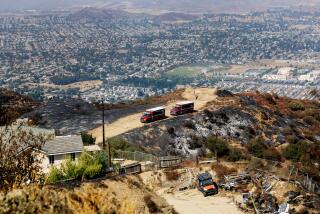Firefighters Gaining Ground Against Blaze Near Yosemite
- Share via
SONORA — An ashen landscape scrolled by below a California Air National Guard Blackhawk helicopter as it broke through a plum-colored pall hanging over the Sierra.
The 11,500-acre Creek fire, the largest in a prematurely busy season of forest blazes, had virtually disappeared. Its walls of orange flames tamed to wan puffs of smoke from hidden embers creeping below the chaparral and pines.
Residents of Tuolumne and Mariposa counties, ordered out only days before, cautiously headed back to their homes. Authorities said the blaze, about 30 miles from Yosemite National Park, is about 85% contained, and hoped to completely corral the blaze by Saturday. Even so, fire personnel on the ground and in the air worried about hotter and drier weather heading into the weekend.
“I think they’ve turned the corner on the Creek fire,” said Ed Isch, the California Department of Forestry and Fire Protection’s liaison to the Air Guard effort. “They’ve got a lot of lines in. They just have to make sure they hold what they’ve got.”
More than 300 fire vehicles still lined roadways and newly cut firebreaks that lace the mountains in ocher scars, waiting to see if the fire would rise again. Some residents of Groveland lazed on a lakeside beach and watched the Blackhawks dip their 700-gallon buckets into Pine Mountain Lake and veer off toward a fire that only days ago roared in orange walls and sent up plumes of smoke that choked out the sun. A banner spread on the patio of one home said, “Thank You, Firefighters.”
September hasn’t even begun, and already the Department of Forestry has had to call in the Air National Guard, after running out of private contractors to fight the aerial battle in seven major fires. “We’re the last in, and the first out,” said Maj. Stan Zezotarski, spokesman for the California Air National Guard.
About 50 guard members flew eight helicopters--four Blackhawks and four massive CH-47 Chinooks toting swimming-pool-sized buckets that hold 2,000 gallons--from Castle Airport, a decommissioned air base north of Merced. They dipped massive orange buckets into lakes and reservoirs, then whisked off toward the still smoldering slopes in the Sierra foothills.
“We were kidding about it yesterday--it’s just a sophisticated bucket brigade,” Lt. Col. Kent During, who coordinated the Guard forces at Castle Airport, said Thursday.
Four homes and four outbuildings were destroyed in the Creek blaze, which nibbled close to the footings of dozens of residences--some posh and palatial, some modestly rustic--before firefighters beat back the flames. The effort here has cost $3.5 million and used 2,453 firefighters and supervisors, said James Wright, assistant deputy director for fire prevention at the Department of Forestry in Sacramento.
Three other major California blazes remained uncontained Thursday, Wright said. The Leonard fire, near San Andreas, had burned 4,185 acres and destroyed two residences and nine other buildings. It was about 40% contained, Wright said. Federal authorities, meanwhile, fought the North Fork blaze, near Oakhurst, which was 30% contained and had burned 2,930 acres. In addition, the Highway fire, two miles east of Dunlap in Fresno County, was 20% contained and had burned 2,821 acres.
With scores of even larger fires consuming thousands of acres throughout eight Western states, firefighting resources have been taxed to the limit--with as many as three more months of burning season left in some areas, and the heart of Southern California’s fire season still ahead.
“This is my third trip up north already and it’s only August,” said Tim Williams, a battalion chief with the Department of Forestry in Riverside, who rode as a spotter to direct water drops from Guard Blackhawks on Thursday.
Conditions statewide are bone-dry, after several consecutive years of low precipitation, according to the agency. During a morning briefing that ran through the humidity conditions of fuel--trees, brush and grass--Isch said of the grass, “I’m surprised it doesn’t just self-ignite.”
About 90% of the National Guard troops deployed here are part-timers who have gone well beyond their commitments of two weeks per year.
Chris Shaw normally patrols West Los Angeles for the Los Angeles Police Department, but was serving as crew chief on a Blackhawk that flew over the Creek fire Thursday.
“Three days ago it was a pretty awesome fire,” Shaw said. “We were flying over flames. You could feel the heat radiating up. There were 150-foot trees going up in flames.”
For the first time, the Defense Department placed the California Guard in charge of the eight C-130 fire retardant-dropping planes, usually scattered in four different states. The craft have dropped 348 tons of fire retardant on dozens of blazes, Zezotarski said. Four of the aircraft are operating exclusively in California, after cool and wet weather helped reduce fires in the Northwest, he said.
More to Read
Sign up for Essential California
The most important California stories and recommendations in your inbox every morning.
You may occasionally receive promotional content from the Los Angeles Times.














